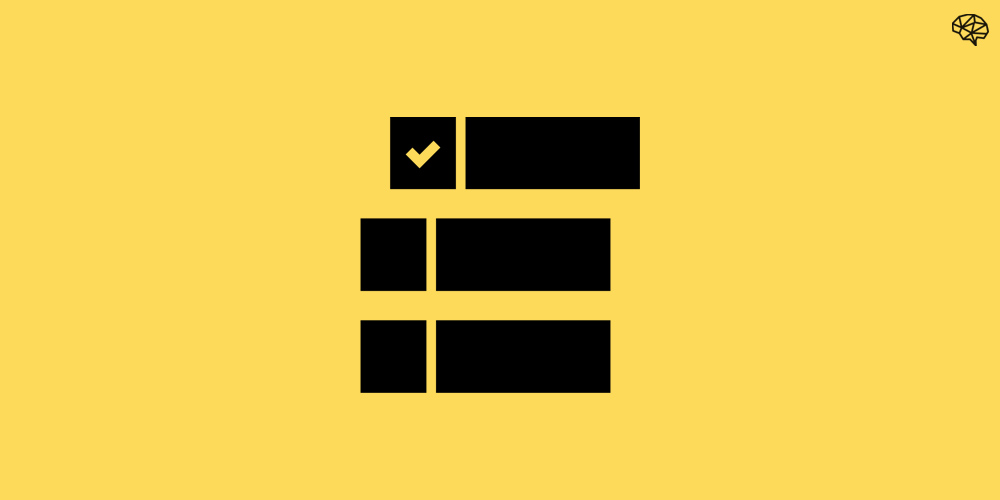Do you ever feel overwhelmed when you look at your to-do list?
You sit down with a long list of items only to feel paralyzed with inaction. You want to start chipping away at the important work that sits in front of you, but you’re not even sure where to begin.
You’re not alone. It’s very common to feel overwhelmed by the mountain of work in front of you. But like any mountain worth conquering, the trick is to take it one step at a time.
To help you overcome this mountain, I want to share with you some simple guiding questions you can ask yourself to minimize that dreadful feeling of overwhelm and make your to-do list feel much more effortless.
Here are 5 guiding questions we’ll cover:
- What can I make unnecessary?
- Have I clarified the problem I’m solving for?
- Have I defined what done looks like?
- What are the minimal amount of steps I need to complete this?
- Do I know what the first action I need to take?
Let’s dive into each.
1. What can I make unnecessary?
This first question helps you identify what you can remove from your list. If you are able to pair down your to-do list only to the essential items, you’ll find a good portion of your smaller tasks disappear.
To achieve this, I like to ask the focusing question shared by Gary Keller in his best-selling book, The One Thing:
“What’s the one thing you can do, such that by doing it, everything else will be easier or unnecessary?”
Gary Keller, The One Thing
If you take a look at your to-do list, there are often a handful of items all related to the same problem. The key is to find (or create) the ONE item you can do that will make the remaining items related to that problem easy or unnecessary.
As a simple example, imagine you had the following tasks on your list all related to a new product launch:
Send Tracy an update on the new product sales page
Provide John with the latest status on launch emails
Send Joanie the product marketing assets she can share with partners
Create a Google sheet to show an up-to-date status for the launch
By focusing on the last item first – creating a Google sheet that provides an up-to-date status report – you essentially make the remaining items easier (and unnecessary in the future) because you now have a sheet that has the information you otherwise would have had to send.
The focus question is about identifying that crucial first domino to your problem that, once pushed, will effortlessly knock down the rest.
(On the topic of pruning your task list, read about reverse piloting.)
2. Have I clarified the problem?
How often have you worked through a task or project only to find out you’ve completely missed the mark on what you needed to do?
My friend Peter Nakamura (who I interviewed here), reminded me of this little gem to keep top of mind –

If you’re not clear about the problem you’re solving for, you risk moving in the wrong direction. The farther you go with the project, the larger the discrepancy becomes between what you think the end target is and what the actual end target is. Ultimately, you end up having to scrap the work and start over again.
The solution is simple: before beginning a project, get clear on the exact problem you’re solving for. If it’s a request from a client, or boss, or colleague, get clear on the initial trajectory and have regular check-ins to make sure you’re moving in the right direction.
3. Have I defined what done looks like?
If you want to make a task nearly impossible to complete, set a really vague definition of done.
Each task on your list should have a clear definition of done. If it’s your own idea, get clear on what the finished product looks like before you start. Get clear on whether you’re building the 70% solution or the 98% solution. Similarly, if it’s a request from a client, boss, or colleague, get clear with them on exactly what the deliverable should be.
For example, if you’ve been asked to create a presentation for a client, get clear on the definition of done at the outset. It doesn’t make sense to create a 37 slide deck with fancy visuals and intricate transitions if all they needed was seven slides with basic headlines and bullet points.
One simple way to do this is to write out an ‘achieved when’ line for each task on your list.
Task: create a presentation for client X
Achieved when: I’ve created a presentation deck with 7-10 slides and shared with the team at least a day before the presentation
Task: design an email campaign to promote our new apparel line
Achieved when: email is created, approved by manager, and scheduled
When you know what done looks like, you can tackle your work with more confidence and clarity.
4. What are the minimal amount of steps I need to complete this?
One of the reasons tasks take longer than they should is because we have a tendency to overcomplicate and overengineer everything.
As I’ve written before, we’ve come to this collective (although misguided) agreement that the right solution to a problem has to be the most complicated one. We believe that the 10-step solution is by default better than the 3-step solution. As a result, we often take the more difficult path.
What are the minimal amount of steps I need to complete this?
With this question, the goal is to identify the minimal amount of steps required to tackle the problem. This is where minimal viable thinking becomes handy.
In the startup world, entrepreneurs look to validate their idea by first creating a minimal viable product. This is a very rough version of what the product would ultimately look like with very rudimentary features and clunky design, but it helps the startup validate their idea and get valuable consumer feedback without committing a large amount of time, effort, and resources up front.
Similarly, you want to identify your minimal viable solution. How can you complete the task at hand in the least amount of time and the fewest resources possible while still solving the problem.
Here’s an example that happened to us recently: our app team wanted to showcase a live feed of our iOS app reviews on our website with the hypothesis that this would get more shoppers adding the free trial because they would see all these amazing reviews.
The complex solution was where everyone seemed to gravitate to – let’s get the web development team to dynamically pull reviews from the app and Play store and our UX/UI designer to get them to display beautifully on the site. This would have required a lot of time and development resources to validate the hypothesis.
The minimal viable solution was a much simpler approach – grab a few screenshots of some great app reviews, add them to the site, and see if this improves the uptake rate of the free trial. This was a much simpler and faster way to validate the hypothesis.
Use minimal viable thinking to simplify your tasks at hand. More often than not, you’ll find that where you thought an elaborate solution was desired, a simple one would more than suffice.
5. Do I know what the first action I need to take?
All the questions thus far are really just prep work. But you haven’t made any progress on your list quite yet. The final question is the key to conquering any to-do list: do I know what the first action I need to take?
We often get paralyzed with inaction when we don’t have clarity on the very first step we need to take on a task or project.
We look at the mountain in front of us and get overwhelmed by what lies ahead instead of focusing on that first step we need to take upwards. Similarly, we look at the project in front of us and get overwhelmed by the volume of tasks that lay ahead instead of focusing on the first action to take.
The objective is to make your first step as simple as possible. The easier the first action is, the easier it will be to break that inertia and start building momentum towards the top of that mountain.
Final thoughts
It’s every easy to get overwhelmed with our to-do lists. There’s simply too much work to get done and never enough time.
The guiding questions I’ve laid out here can help you pair down your list to the essential work and make the tasks that remain more effortless to work through. You don’t need to ask every question for every task, but find and use the ones that help you feel less overwhelmed and take action towards completing your important work.
And while it may feel as if asking these questions up front is work in itself (it is), answering them is the equivalent of sharpening your axe before cutting down the tree. Spend the time up front to understand the problem, discuss the array of solutions available, and get clear on the desired outcome before you start tackling the problem and you’ll end up requiring fewer swings at the tree to take it down.
This is how you conquer your to-do list effortlessly.
✌




